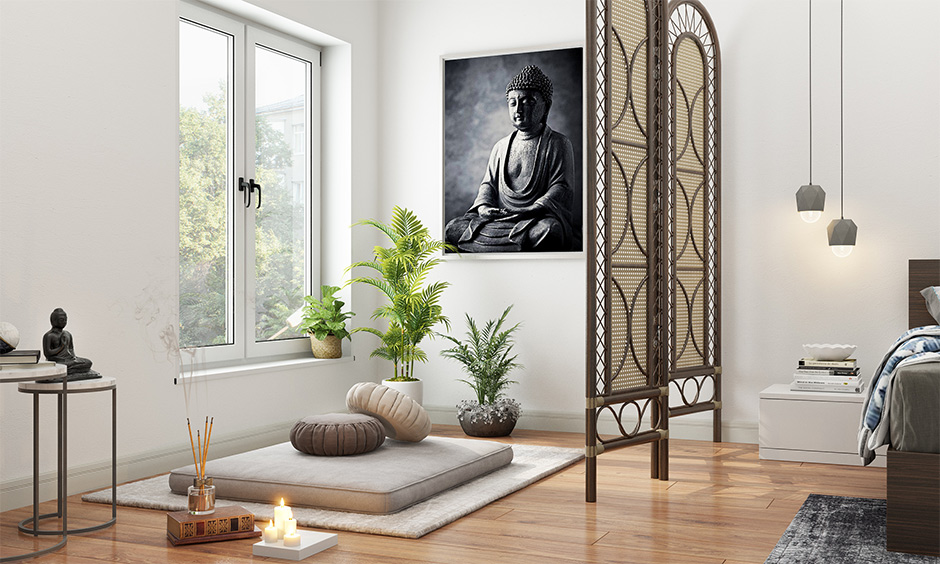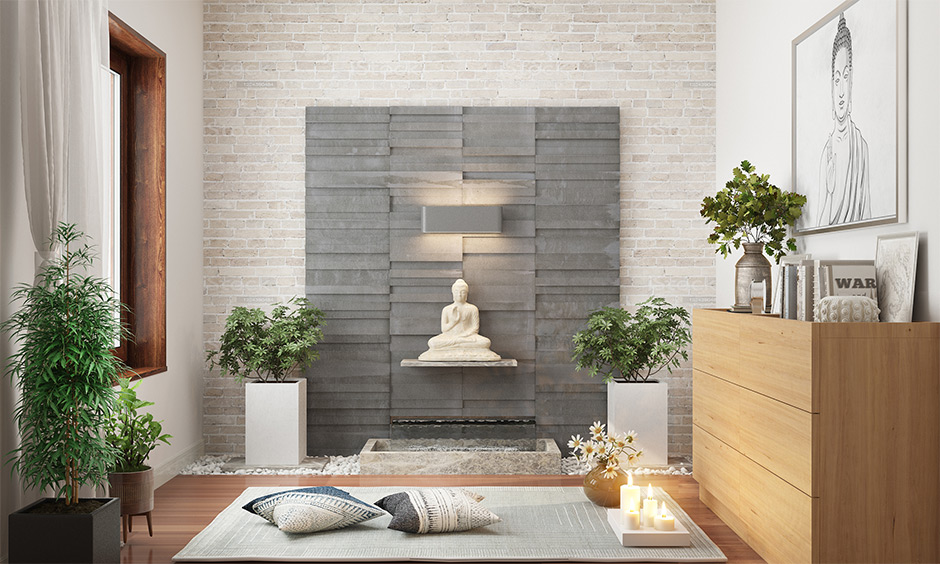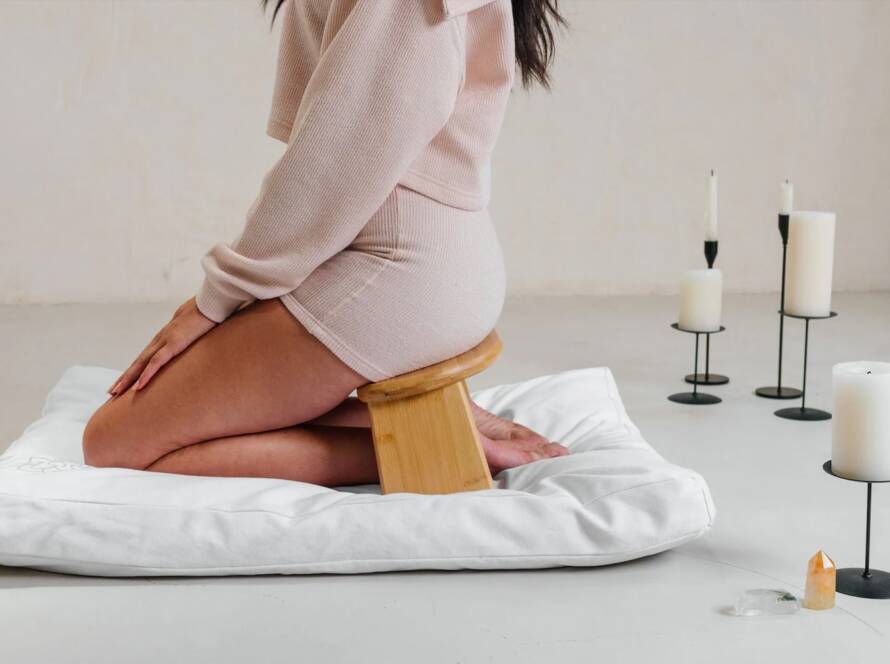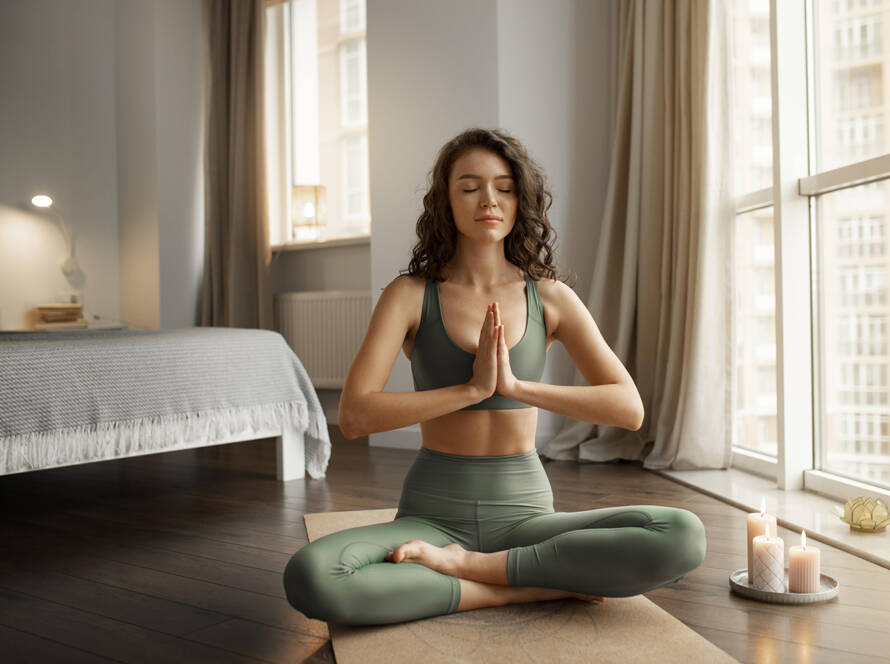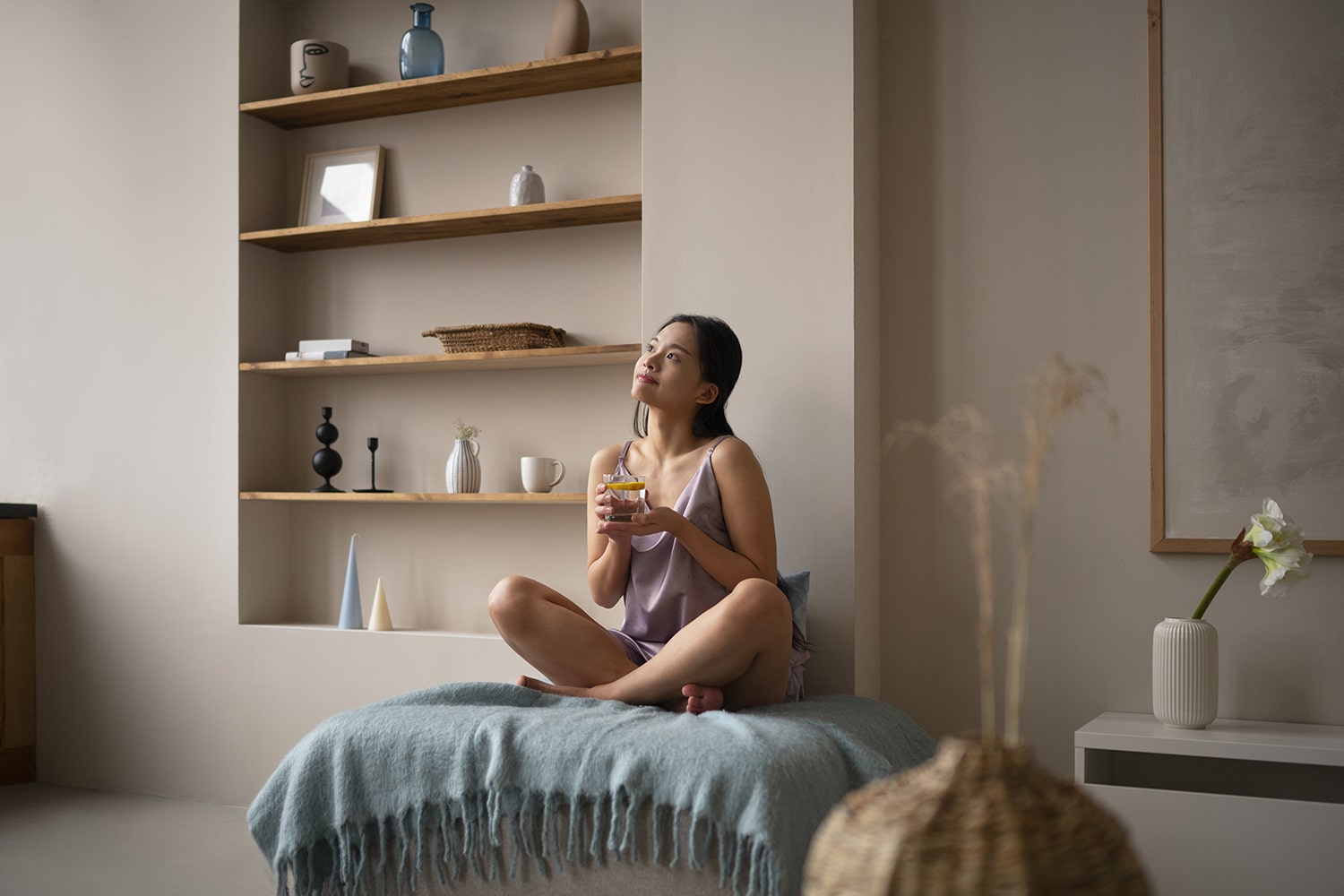
Meditation Décor - Creating that Perfect Space
Creating a space dedicated to meditation can enhance the overall experience and help you achieve a deeper state of relaxation and mindfulness. Here are some tips and ideas for meditation decor, along with product recommendations to help you set up the perfect meditation space.
Choose a Quiet Space
- Location: Select a room or a corner in your home that is quiet and free from distractions.
- Natural Light: Prefer a space with natural light. If that’s not possible, use soft lighting to create a calming atmosphere.
Comfortable Seating
Comfortable meditation decor seating is essential for achieving a serene and focused practice. Designed to provide optimal support, this seating typically features ergonomic contours that promote proper posture, ensuring that your spine remains aligned and your body stays relaxed. The cushions are often filled with high-density foam or natural buckwheat hulls, which mould to your body’s shape, offering personalized comfort and stability. The seat height is carefully calibrated to allow your knees to rest below your hips, enhancing circulation and reducing strain on your joints. Covered in soft, breathable fabric, these seats are not only functional but also aesthetically pleasing, blending seamlessly into any meditation space. Whether you prefer a traditional meditation cushion, a bench, or a chair, the right seating can significantly enhance your meditative experience, helping you to stay present and comfortable during your practice.
Meditation Decor Cushions (Zafu):
- Leewadee Meditation Cushion Set
- Sunshima Yoga Meditation Cushion – Zafu Pillow
- HIGOGOGO Large Floor Square Tufted Seat Pillow
Meditation Decor Chairs:
- TreaHome Meditation Bench
- plantainbros Adjustable Height Meditation Stool
- Ergonomic Kneeling Meditation Yoga Bench
Yoga Mats:
- Nidra Yoga Mat, Professional Yoga and Pilates Mat
- Liforme Original Yoga Mat – Free Yoga Bag Included
- YOGATI Natural Rubber Yoga Mat with Yoga Bag and Carry Strap
Calming Colours
Calming colours play a pivotal role in creating a serene meditation environment, fostering a sense of peace and tranquillity. Soft, muted tones like pastel blues, gentle greens, and warm neutrals are ideal, as they have been shown to reduce stress and promote relaxation. These colours mimic nature, evoking the soothing presence of the sky, water, and earth, which can help to ground and centre your mind during meditation. Incorporating these hues into your meditation space—whether through wall paint, cushions, or decorative elements—can create a harmonious atmosphere that encourages mindfulness and inner calm. The subtle interplay of these calming colours helps to quiet the mind, allowing you to focus more deeply on your breath and inner experience, ultimately enhancing the overall meditative practice.
- Palette: Use soothing colours like soft blues, greens, earthy tones, and neutrals.
- Accents: Incorporate accent pieces in calm colors to maintain a tranquil environment.
Natural Elements
Incorporating natural elements into your meditation practice can profoundly enhance your connection to the earth and deepen your sense of tranquillity. Natural elements like wood, stone, water, and plants introduce a grounding energy to your meditation space, creating a serene and harmonious environment. Wooden floors or furniture, with their organic textures and warm tones, provide a solid and comforting foundation. Stones and crystals can serve as focal points, offering stability and balance. The gentle sound of flowing water from a small fountain or the presence of lush, green plants can invigorate the senses and promote a feeling of rejuvenation. These elements not only beautify the space but also engage your senses in a way that draws you closer to nature, helping to clear your mind and enhance your meditative practice. By surrounding yourself with the simplicity and purity of natural elements, you create a sanctuary that fosters peace, reflection, and inner calm.
Plants:
- Lifeup Buddha Tabletop Water Fountains Indoor Waterfall
- Air Purifying Plant Collection 3 Indoor House Plants Snake Plant
- Spathiphyllum Peace Lily – Large Plant
Water Features:
Decorative Elements
Decorative elements in a meditation space can significantly enhance the ambiance and support a deeper, more enriching practice. Thoughtfully chosen items like statues, artwork, candles, and incense holders add a personal and spiritual touch to your sanctuary. Statues of deities, such as Buddha, serve as visual reminders of your spiritual goals and can inspire a sense of reverence and focus. Artwork featuring serene landscapes or abstract designs can evoke feelings of peace and introspection. Soft, flickering candlelight creates a warm, inviting glow, while the gentle aroma of incense can calm the mind and elevate the spirit. These decorative elements not only beautify the space but also engage the senses, helping to anchor your attention and promote a mindful atmosphere. By infusing your meditation area with these meaningful and aesthetically pleasing items, you create an environment that nurtures tranquillity, concentration, and a deeper connection to your practice.
Candles and Incense:
- Chakra Candle Box Set of 7 with Crystals Inside
- Simply Vedic Premium 7-Chakra Incense Sticks| for Chakra Activation
- Zen Garden Incense Stick Holder Candle Tray
Statues and Symbols:
- Qinlang 12 inch White Ceramic Meditation Buddha
- Amosfun Buddha Statues Figurine Miniature Sandstone Buddha
- Magnetic Glass Board Yoga Zen Meditation 90x60cm Print Wall Art
Textiles
Textiles play a vital role in creating a comfortable and inviting meditation space, enhancing both the aesthetic and sensory experience of your practice. Soft, natural fabrics like cotton, linen, and silk are ideal choices, as they provide a gentle touch against the skin and allow for breathability. Cushions and mats covered in these textiles offer a plush and supportive foundation, ensuring comfort during prolonged sessions. Drapes and rugs in soothing colours and textures can transform the space, adding layers of warmth and cosiness. These textiles not only contribute to physical comfort but also create a serene visual appeal that encourages relaxation and focus. Whether it’s a handwoven blanket, an intricately patterned tapestry, or simple, elegant floor cushions, the right textiles can make your meditation area a true sanctuary of peace and comfort, inviting you to fully immerse yourself in your practice.
Rugs and Blankets:
- hi-home Boho Round Rug 120CM
- Florensi Meditation Mat Zabuton – Meditation Cushion Sitting & Kneeling
- Large Green Ombre Mandala Tapestry Wall Hanging Decor
- Ambesonne Yoga Curtains Woman Silhouette Meditating
- Zen Blackout Curtains
- Mandala Window Curtains meditation decor
Sound
Meditation sounds are an integral part of creating a serene and immersive environment that enhances your practice. These sounds, ranging from gentle nature noises like flowing water, rustling leaves, and birdsong to soothing instrumental music, help to calm the mind and deepen your focus. The rhythmic pattern of these sounds can guide your breathing and provide a consistent anchor for your attention, making it easier to enter a meditative state. Instruments such as Tibetan singing bowls, chimes, and gongs produce harmonic tones that resonate with the body’s energy centres, promoting balance and relaxation. Digital soundscapes or guided meditations can also be incorporated, offering structured paths to mindfulness and inner peace. By enveloping yourself in these tranquil sounds, you create an auditory backdrop that supports concentration, reduces stress, and fosters a profound sense of calm and well-being, enriching the overall meditative experience.
Music and Bells:
- Simply Meditation Box Set
- Artcome Tibetan Meditation Set
- Music for Mindfulness, Relaxation, Meditation and Inner Peace Vol:1
Personal Touches
Adding personal touches to your meditation space can make it uniquely yours, fostering a deeper sense of comfort and connection. These elements, such as cherished mementos, photos, or symbolic objects, infuse the area with your personal energy and intentions. A favourite cushion or blanket, chosen for its comfort and sentimental value, can enhance your physical and emotional well-being. Displaying items like meaningful crystals, family heirlooms, or travel souvenirs can evoke positive memories and feelings of gratitude. Personal touches might also include handmade crafts, inspirational quotes, or artwork that resonates with your spiritual journey. By incorporating these personalized elements, you transform your meditation space into a true reflection of yourself, creating an intimate environment that supports deeper introspection, emotional healing, and a stronger connection to your practice.
Photos and Art:
- Buddha Canvas Wall Art Zen Statue Painting
- Buddha Head Wall Decor Indigo Blue Buddha
- Buddha Statue Stone Meditation XL Giant Panel
Journal and Books:
- Candidora Meditation Journal — For Women
- Clever Fox Self-Care Journal – Wellness & Daily Reflection
- The Zen Monkey and the Lotus Flower
Minimalism
Minimalist decor in a meditation space emphasizes simplicity and clarity, creating an environment that fosters focus and tranquillity. By reducing clutter and choosing only essential, thoughtfully selected items, you can design a serene and harmonious area that minimizes distractions. Clean lines, neutral colour palettes, and natural materials like wood and stone contribute to a calming and grounded atmosphere. The absence of excess allows for a spacious feeling, encouraging a sense of openness and mental clarity. Simple cushions, a low bench, and a single piece of art or a small plant can serve as focal points, enhancing the aesthetic without overwhelming the senses. This minimalist approach helps to clear both the physical space and the mind, making it easier to achieve a deep, uninterrupted meditative state. In a minimalist meditation space, every element serves a purpose, promoting peace, introspection, and a profound connection to the present moment.
Special Enhancements
Special enhancements in a meditation space elevate the practice by integrating elements that deepen relaxation and mindfulness. These enhancements may include soft lighting options such as dimmable lamps or candles, which create a soothing ambiance conducive to meditation. Aromatherapy diffusers with calming essential oils like lavender or frankincense can enhance the atmosphere, promoting a sense of peace and mental clarity. Additionally, incorporating adjustable seating options like ergonomic chairs or versatile cushions allows for personalized comfort and proper posture, supporting longer meditation sessions. Sound systems or headphones playing tranquil music or nature sounds provide auditory cues that aid in concentration and relaxation.
Essential Oils:
- Essential Oil Blend – Calming Stress Relief Oils
- Gya Labs Mindful Meditation Essential Oil Blend
- Meditation, Anti – Anxiety – 100% Pure and Natural
Crystals:
Meditation Décor Example Layout
Meditation layouts are carefully curated arrangements designed to optimize tranquillity and focus within a space. A traditional layout might feature a central meditation cushion or mat placed on a soft, woven rug, surrounded by minimalist décor like a small, serene fountain emitting gentle water sounds. Natural elements such as potted plants or a bonsai tree add a grounding touch, while soft lighting from paper lanterns or candles creates a warm, calming glow. Alternatively, a modern layout could include a sleek, ergonomic meditation chair positioned near a large window overlooking a peaceful garden, allowing natural light to flood the space. This setup might incorporate digital enhancements such as a smart speaker playing ambient meditation music or guided sessions. Whether traditional or modern, these thoughtfully arranged layouts aim to create a serene sanctuary that supports deep introspection and mindfulness, encouraging a tranquil state of being during meditation practice.
Some examples:
Corner Setup: In a small space, create a meditation nook with a cushion, a small table for candles and incense, some plants, wall art and a divider.
Room Setup: In a larger space, include a comfy chair, a rug, multiple plants, a water fountain, and a small bookshelf with meditation-related books.
Creating a dedicated meditation décor space that reflects your personal style and preferences can greatly enhance your practice, making it a sanctuary for relaxation and inner peace.

